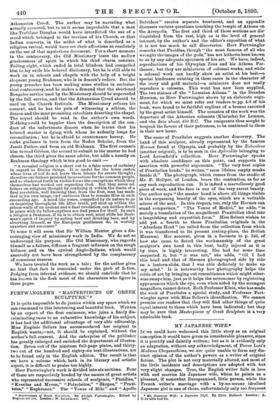FURTWANGLER'S "MASTERPIECES OF GREEK SCULPTURE."*
IT is quite impossible to do justice within any space which we can command to this interesting and beautiful book. Written by an expert of the first eminence, who joins a finely dis- criminating taste to an exhaustive knowledge of his subject, it has had the additional advantage of very able editorship. Miss Eugenie Sellers has accommodated her original to English wants,—not, it should be explained, without the author's full consent. And the enterprise of the publisher has greatly enlarged and enriched the department of illustra- tion. Seven out of the nineteen fall-page plates, and thirty- two out of the hundred and eighty-six text-illustrations, are to be found only in the English edition. The result is that we have a volume which, both in its literary and artistic aspect, it is difficult to praise too highly.
Herr Furtwangler's work is divided into six sections. Four of these are respectively headed by the names of great artists who represented successive schools of sculpture, " Pheidias," "Kresilas and Myron," " Polycleitos," " Skopas," "Praxi- teles," "Euphraizor." The "Venus of Milo" and "Apollo
• Masterpieces of Greek Ssu'pture. By Adolph Furtwingler. Edited by EugCnic net era. London: W. iseineunann. 1b93,
Belvidere" receive separate treatment, and an appendix discusses various questions touching the temple of Athena on the Acropolis. The first and third of these sections are dis- tinguished from the rest, high as is the level of general interest, by the author's and the editor's exposition of what, it is not too much to call discoveries. Herr Fartwangler remarks that Pheidias, though "the most famous of all who wrought the images of the gods," has not hitherto been known to us by any adequate specimen of his art. We have, indeed, reproductions of his Olympian Zeus and his Athena Par- tlaenos ; but they are miniatures of colossal works, and while a colossal work can hardly show an artist at his best—a, special hindrance existing in these cases in the character of the ivory and gold material—a miniature does not really reproduce a colossus. This want has now been supplied_ The two statues of the " Lemnian Athena" in the Dresden Museum, as Herr Furtwangler shows by an elaborate argu- ment, for which we must refer our readers to pp. 4-8 of his book, were found to be faithful replicas of a bronze executed by the great artist himself. The occasion of the work was the departure of the Athenian colonists (Kleruchs) for Lemnos, and the date about 450 B.C. The emigrants thus sought to bespeak the favour of their patroness, to be continued to thexn in their new home.
The name of Praxiteles suggests another discovery. The hand of this sculptor, already represented by the famous Hermes found at Olympia, and probably by the Eubouleus (another original), is to be seen in the Aphrodite belonging to Lord Lezonfield's collection. Herr Furtwangler speaks with absolute confidence on this point, and supports his assertion with powerful arguments. "The very best copies of Praxitelian heads," he writes, "seem lifeless empty masks beside it." The photograph, which comes from the studio of Mr. F. Hollyer, of London, bears the contention, as far as any such reproduction can. It is indeed a marvellously good piece of work, and the face is one of the very rarest beauty. Our author says "the master hand is above all things visible in the surpassing beauty of the eyes, which are a veritable mirror of the soul. In this respect, too, only the Hermes can stand comparison." "The Venus of Medici," he adds, " is- merely a translation of the magnificent Praxitelian ideal into a languishing and coquettish form." Miss Sellers wishes to. add yet a fourth to these Praxitelian originals in the "Aberdeen Head" (so called from the collection from which it was transferred to its present resting-place, the British Museum). Her account, given in a footnote to p. 346, of how she came to detect the workmanship of the great. sculptor's own hand in this bust, badly injured as it is by time, is highly interesting. She had for some time suspected it, but " it was not," she adds, "till I had this bead and that of Hermes photographed side by side on a lantern-slide, that I was able definitely to make up. my mind." It is noteworthy how photography helps the critic of art by bringing out resemblances which might other- wise escape him, just as it helps the astronomer by registering appearances which the eye, even when aided by the strongest. magnifiers, cannot detect. Both Professor Klein, who has made the work of Praxiteles a special study, and Professor Furt- wangler agree with Miss Sellers's identification. We cannot. promise our readers that they will find other things of quite equal interest to those which have been indicated ; but they may be sure that Masterpieces of Greek Sculpture is a very admirable book.






































 Previous page
Previous page